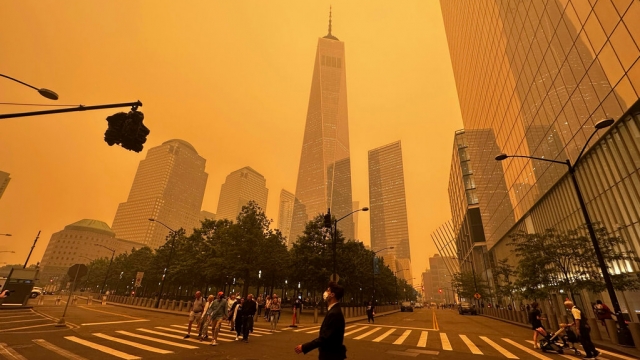Air quality alerts were issued for sections of the East Coast spanning from New Hampshire to South Carolina for Wednesday.
The No. 1 culprit: Canadian wildfires.
Just how bad is the air quality?
Air quality is gauged by measuring how prevalent fine particles, generally 2.5 µm or smaller, are in the air. That is then put on a scale from 0-500. This is known as the air quality index.

When the air quality index reaches 101, it is considered unhealthy for sensitive groups. When it reaches 151, it is considered unhealthy for all groups; and if it goes above 201, it is considered very unhealthy.
As of early Wednesday, the air quality index in Philadelphia, New York and several other major cities is well above 151, with some areas above 200.
Even cities to the west, such as Detroit and Columbus, Ohio, experienced air quality indexes above 151 Wednesday morning.
Kingston, Ontario, near the border with New York, reported an air quality index of 448 Wednesday morning, which would be considered hazardous for everyone.
"Fine particles can get deep into our lungs; they can bypass the body's defenses and even cross into the bloodstream, causing, you know, cardiovascular issues," said William Barrett, senior director of the Clear Air Initiative with the American Lung Association.
SEE MORE: Atmospheric carbon dioxide levels saw another steep jump in 2023
The source of the smoke
According to National Resources Canada, there are dozens of wildfire hotspots throughout Canada, but the ones causing the most smoke in the Northeastern U.S. are in central Quebec. Models from Canadian forecasters show constant plumes of smoke traveling from north to south. Upstate New York, in particular the Buffalo and Rochester areas, have been seeing the most wildfire smoke.
It then disperses throughout the rest of the Northeast and Midwest.
According to Canadian broadcaster CTV, authorities are focusing on towns and critical infrastructure with so many fires burning. There are nearly 10,000 Quebec residents who have evacuated their homes.
How to combat poor air quality
The U.S. Environmental Protection Agency offers tips on its website on what to do when there is smoke in the air.
The EPA recommends checking the air quality frequently as it can change throughout the day; wearing a mask that protects you from smoke; taking it easy while outside, avoiding strenuous activity; and rescheduling outdoor work tasks.
When indoors, the EPA recommends running central air conditioning to filter the air and using a portable air cleaner. It also recommends avoiding doing activities indoors that can kick up pollutants, such as vacuuming or frying foods.
You can check the air quality for your area on the EPA's website.
Flights canceled and delayed
Following the presence of smoke, the Federal Aviation Administration lifted the ground stop for flights heading to New York's LaGuardia airport. However, certain flights are experiencing delays.
"The FAA is now slowing traffic from the East Coast and Midwest bound for Philadelphia International Airport due to reduced visibility from wildfire smoke," the agency said.
Shortly after the FAA's announcement, LaGuardia Airportannounced that low visibility from the smoke was impacting flight arrivals and departures, and encouraged travelers to check with their respective airline for updates.
According to FlightAware, 124 flights have been canceled and 2,081 flights have been delayed in the U.S. as of 3:20 p.m. Wednesday.
Trending stories at Scrippsnews.com



